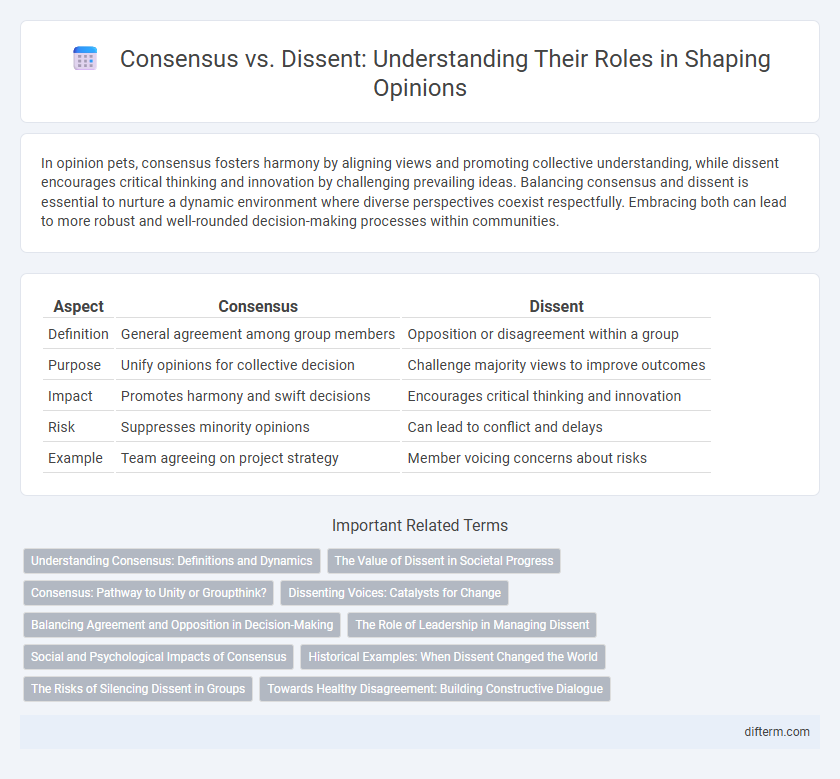In opinion pets, consensus fosters harmony by aligning views and promoting collective understanding, while dissent encourages critical thinking and innovation by challenging prevailing ideas. Balancing consensus and dissent is essential to nurture a dynamic environment where diverse perspectives coexist respectfully. Embracing both can lead to more robust and well-rounded decision-making processes within communities.
Table of Comparison
| Aspect | Consensus | Dissent |
|---|---|---|
| Definition | General agreement among group members | Opposition or disagreement within a group |
| Purpose | Unify opinions for collective decision | Challenge majority views to improve outcomes |
| Impact | Promotes harmony and swift decisions | Encourages critical thinking and innovation |
| Risk | Suppresses minority opinions | Can lead to conflict and delays |
| Example | Team agreeing on project strategy | Member voicing concerns about risks |
Understanding Consensus: Definitions and Dynamics
Consensus represents collective agreement achieved through collaborative dialogue, emphasizing common ground while respecting individual perspectives. Understanding its dynamics involves recognizing the balance between unity and the inclusion of diverse viewpoints to foster sustainable decisions. Effective consensus-building requires active listening, empathy, and negotiated compromise to harmonize differing opinions into cohesive outcomes.
The Value of Dissent in Societal Progress
Dissent drives societal progress by challenging prevailing norms and encouraging critical evaluation of established ideas, fostering innovation and reform. Historical movements such as civil rights and scientific revolutions exemplify how dissent catalyzes transformative change. Embracing diverse perspectives through constructive dissent is essential for democratic resilience and social evolution.
Consensus: Pathway to Unity or Groupthink?
Consensus fosters collective agreement that strengthens group cohesion and drives unified action, enhancing decision-making efficiency and collaboration. However, it can also suppress dissenting voices, leading to groupthink where critical analysis is compromised. Balancing consensus with open dialogue ensures both unity and diversity of thought in effective group dynamics.
Dissenting Voices: Catalysts for Change
Dissenting voices serve as essential catalysts for social and political progress by challenging dominant paradigms and encouraging critical thinking. Their contributions often expose blind spots and injustices overlooked by consensus, fostering innovation and reform. Historical movements such as civil rights and environmental activism highlight how dissent propels transformative change against prevailing norms.
Balancing Agreement and Opposition in Decision-Making
Consensus fosters unity and smoother implementation by aligning team members around shared goals, enhancing cooperation and collective commitment. Dissent introduces critical analysis and diverse perspectives, preventing groupthink and fostering innovation through constructive challenges. Effective decision-making balances agreement to maintain cohesion with opposition to ensure robust, well-rounded outcomes that address potential risks and optimize strategies.
The Role of Leadership in Managing Dissent
Effective leadership plays a crucial role in managing dissent by fostering an environment where diverse viewpoints are valued and constructive debate is encouraged. Leaders who skillfully balance consensus-building with openness to dissent can enhance decision-making quality and innovation within organizations. Emphasizing transparent communication and active listening helps leaders transform dissent into a strategic asset rather than a source of conflict.
Social and Psychological Impacts of Consensus
Consensus fosters social cohesion by aligning group members around shared goals, reducing conflict, and enhancing collective trust. Psychologically, achieving consensus can increase individuals' sense of belonging and validation, reinforcing positive self-identity and group loyalty. However, excessive consensus may suppress diverse perspectives, potentially stifling creativity and critical thinking within social groups.
Historical Examples: When Dissent Changed the World
Dissent has historically catalyzed significant societal transformations, as seen in the American Civil Rights Movement where voices like Martin Luther King Jr. challenged prevailing norms to achieve racial equality. The French Revolution exemplifies how dissent against monarchical rule redefined governance and inspired democratic ideals globally. These instances demonstrate that dissent, by contesting consensus, often drives progress and reshapes political and social landscapes.
The Risks of Silencing Dissent in Groups
Silencing dissent in groups risks creating environments prone to groupthink, where critical evaluation is suppressed and poor decisions proliferate. This suppression undermines innovation by discouraging diverse perspectives and constructive criticism necessary for robust problem-solving. Organizations that tolerate dissent tend to foster resilience and adaptability, enhancing long-term success through informed consensus.
Towards Healthy Disagreement: Building Constructive Dialogue
Healthy disagreement fosters innovation and deeper understanding by encouraging diverse perspectives and critical thinking. Constructive dialogue requires active listening, empathy, and respect for differing opinions to transform dissent into collaborative progress. Embracing conflict as an opportunity rather than a threat supports the development of more effective, inclusive decision-making processes.
consensus vs dissent Infographic

 difterm.com
difterm.com